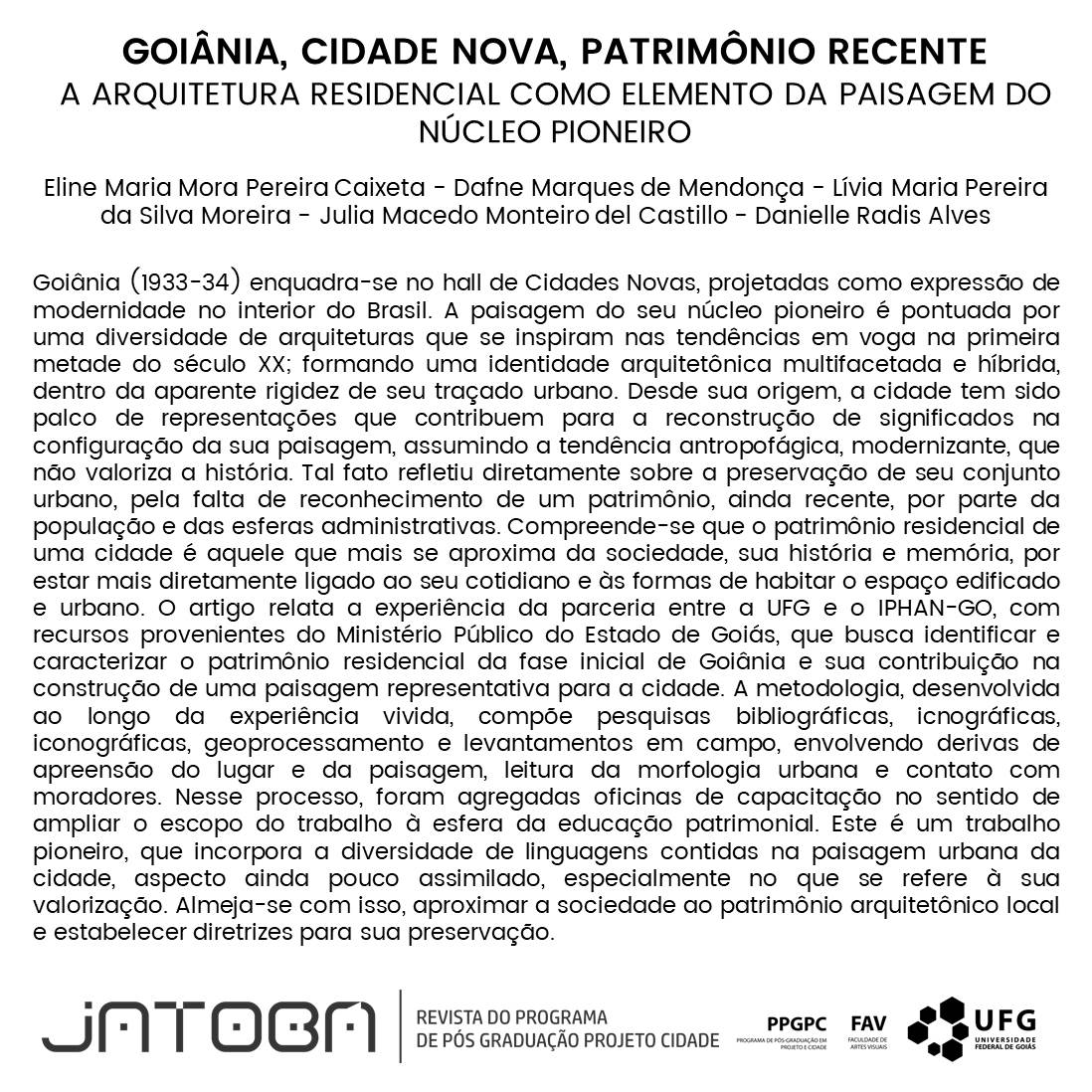Goiânia, new city, recent heritage
residential architecture as a pioneering Core landscape element
DOI:
https://doi.org/10.54686/revjat.v1i.61275Keywords:
City and memory.inventory.historical residences. urban landscape.Goiânia.Abstract
Goiânia (1933-34) fits into the hall of New Cities, designed as an expression of modernity in the interior of Brazil. The landscape of its pioneering core is punctuated by a diversity of architectures that are inspired by the trends in vogue in the first half of the twentieth century; forming a multifaceted and hybrid architectural identity, within the apparent rigidity of its urban layout. Since its inception, the city has been the scene of representations that contribute to the reconstruction of meanings in the configuration of its landscape, assuming the anthropophagic and modernizing tendency that does not value history. This fact reflected directly on the preservation of its urban complex, due to the lack of recognition of a heritage, still recent, by the population and the administrative spheres. It is understood that the residential heritage of a city is the one that comes closest to society, its history and memory, because it is more directly linked to its daily life and the ways of inhabiting the built and urban space. The article reports the experience of the partnership between UFG and IPHAN-GO, with resources from the Goiás State Public Prosecutor’s Office, which seeks to identify and characterize the residential heritage of the initial phase of Goiânia and its contribution to the construction of a representative landscape for the city. The methodology, developed along the lived experience, comprises bibliographic, icnographic, iconographic research, geoprocessing and field surveys, involving drift of apprehension of place and landscape, reading of urban morphology and contact with residents. In this process, training workshops were added to broaden the scope of work to the sphere of heritage education. This is a pioneering work that incorporates the diversity of languages contained in the urban landscape of the city, an aspect that has not yet been assimilated, especially regarding its valorization. The aim is to bring society closer to the local architectural heritage and establish guidelines for its preservation.
Downloads

Downloads
Published
Versions
- 2022-03-23 (2)
- 2019-12-17 (1)
How to Cite
Issue
Section
License
Copyright (c) 2019 Revista Jatobá

This work is licensed under a Creative Commons Attribution 4.0 International License.
- Autores mantém os direitos autorais e concedem à revista o direito de primeira publicação, com o trabalho simultaneamente licenciado sob a Licença Creative Commons Attribution 4.0 que permite o compartilhamento do trabalho com reconhecimento da autoria e publicação inicial nesta revista.
- Autores têm autorização para assumir contratos adicionais separadamente, para distribuição não-exclusiva da versão do trabalho publicada nesta revista (ex.: publicar em repositório institucional ou como capítulo de livro), com reconhecimento de autoria e publicação inicial nesta revista.
- Autores têm permissão para publicar e distribuir seu trabalho online (ex.: em repositórios institucionais ou na sua página pessoal) após a publicação inicial nesta revista, já que isso pode gerar alterações produtivas, bem como aumentar o impacto e a citação do trabalho publicado (Veja O Efeito do Acesso Livre).
- Foram feitos todos os esforços para identificar e creditar os detentores de direitos sobre as imagens publicadas. Se tem direitos sobre alguma destas imagens e não foi corretamente identificado, por favor, entre em contato com a revista Jatobá e publicaremos a correção num dos próximos números.














